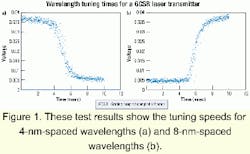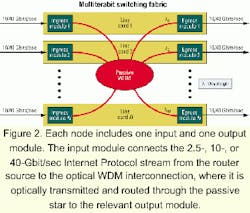Tunable lasers key to data-network migration
Lasers that can switch wavelengths in nanoseconds will enable packet-switched architectures.
ROB PLASTOW, ADC Telecommunications, and DAN SADOT, Xlight Photonics Inc.
During the past two years, wavelength tunable lasers have become firmly established as a mainstream product. Available-or announced-from several vendors, these devices are an increasingly important feature of new and proposed networks.
The acceptance of tunable lasers is largely because tunability simplifies network inventory control as well as system upgrades. With 80 or more wavelengths present in existing systems, each requiring a non-interchangeable transmitter line card, carriers have a giant-sized equipment headache. The use of a single tunable line card as a field replaceable spare for any of the fixed-wavelength cards is an obvious application. Equally attractive is the option to keep a portion of the "fixed" cards tunable to allow for rapid and simple provisioning of new services.
Tunable transmitters can support flexible provisioning of new wavelength circuits in milliseconds, a dramatic improvement over the hours, days, or months needed to manually add or replace transmitter cards. This functionality is particularly attractive in the metro area. The same requirement, however, exists in long haul, leading to the development of wavelength routers that can select both fiber and wavelength.All these applications help enhance service and reduce cost by simplifying aspects of today's networks. However, the real goal is to move from the complex, multilayered, voice-centric networks in use now, to the simpler, Internet Protocol (IP)-centric data networks of the future. Many different approaches have been proposed, including an all-packet-switched environment where the network consists simply of giant routers connected using IP. This approach is the simplest possible in terms of network layers but arguably expensive in terms of physical hardware and difficult in terms of the size of the routing tables involved. Other approaches include using so many wavelengths that circuit switching can be established at will throughout the network or using label switching to establish paths through a network as required. Once multiple layers are introduced into the network, paths can be reconfigured slowly or on a packet-by-packet basis.
The truth is that in all probability, a combination of techniques will be used. This future dynamic network will use terabit routers, reconfigurable optical paths, and techniques such as label switching. Tunable lasers play a critical role in all these solutions.
A key requirement for future systems is the ability to establish rapid-fire connections between any number of nodes in a telecommunications network. That is in contrast to today's networks, which generally have a rigid, time-division multiplexing (TDM) hierarchy building up from low-speed channels at the edge to a core comprising point-to-point fixed-wavelength and fixed-route optical links arranged in SONET rings.
There are various approaches to establishing connectivity. In a traditional TDM network, it is achieved by detecting the optical signal, then multiplexing and demultiplexing the resulting electrical signal at each node. In a router-only approach, the optical signal is detected and individual packets routed electrically at each node. Both of these approaches require extensive-and arguably expensive-equipment at each node.
An intermediate approach is to create a reconfigurable optical layer, where signals remain in the optical domain at some or all intermediate nodes. An optical crossconnect switches the physical path of the light in response to commands from the network-management system. The same functionality can be achieved using a combination of tunable lasers and passive optical WDM components-changing the wavelength changes the physical path. These two approaches are complementary, not competitive. Wavelength provides an extra dimension of switching. The network can be configured to switch paths only by space switching or only by wavelength switching, but in most cases the use of both is optimum.
The future network will transmit primarily IP-based data. The availability of lasers that can switch wavelengths in nanoseconds allows the option of switching each IP packet individually, opening up new architectures in the network and within core switches and routers. To achieve that, it is necessary to examine the laser structure.
Tunable lasers come in many forms, but to "tune" the lasing wavelength, all of these devices have to change the optical properties of the lasing cavity in some way.
The easiest approach for existing telecom systems is simply to change the temperature of the existing distributed-feedback laser. Unfortunately, that offers very limited tuning range-three to four 50-GHz-spaced channels at best. It is also slow, taking as long as seconds to stabilize.
Mechanically tuned lasers have long been used in instrumentation and offer a way to achieve tuning over the full C-band. The two issues here are the difficulty of obtaining and demonstrating the reliability required for telecommunications and a relatively slow switching time of milliseconds to seconds. Size and cost of assembly are also drawbacks. The use of micromechanical structures such as micro-electromechanical systems (MEMS) can potentially improve the size and cost. Mechanically tuned lasers still have a relatively slow switching time set by the need to physically move part of the device.A technology, which offers the tuning speed needed for packet switching and the tunability required for full network connectivity is the use of a distributed Bragg reflector monolithic chip as the laser. This device uses a Bragg grating within the structure to select the lasing wavelength and changes the refractive index of the grating, and hence the wavelength of the laser, by changing current through that section of the device. As the only movement is electrons in a pn junction, the same physics applies as in integrated circuits-smaller is better, faster, and cheaper-giving tuning speeds in nanoseconds. For lasers such as the grating-coupled sampled reflector (GCSR), this speed is obtainable for tuning across the full C-band, without modification of the chip or package. The challenge is to produce fast control and drive electronics around the laser.
The HORNET project at Stanford University, sponsored by Sprint, is one example of a testbed for fast optical packet switching where GCSR lasers are used to provide very rapid switching of wavelengths on a packet-by-packet basis. Last year, HORNET demonstrated fast switching using a GCSR laser in a design for a 100-node metropolitan-access network. Recently, HORNET demonstrated errorless transmission with a power penalty of only 0.5 dB for a tunable transmitter and a burst-mode packet receiver. The transmitter tunes a GCSR laser throughout the C-band with a maximum tuning duration of 15 nsec. The receiver uses a simple radio frequency clock recovery circuit, which extracts a clock from the incoming data and uses it to recover the packet with less than 40 nsec of synchronization time.1 These results demonstrate that fast tunable transmitters can perform in real system tests, not just as laboratory curiosities.
The high-speed tunable transmitter is the basic building block of a dynamic WDM-based crossconnect switching fabric. Fast direct modulation and commercial electronics that allow sub-nanosecond tuning of GCSR lasers provide the ability to construct optical WDM switching-fabric systems and subsystems operating at nanosecond tuning speeds.2 An example of the high-speed tuning capability (<2 nsec) of a prototype board is depicted in Figure 1.
A general illustration of an interconnection architecture, which makes the most effective use of the optical-switch fabric, is shown in Figure 2. Each node includes one input and one output module. The input module connects the 2.5-, 10-, or 40-Gbit/sec IP stream from the router source to the optical WDM interconnection, where it is optically transmitted and routed through the passive star to the relevant output module. The output module receives the optical data stream from the passive star. The data is then retransmitted as an IP stream from the router to the desired destination. The tunable-laser transmitter is located at the output of each of the input modules. All the nodes are optically interconnected through optical fibers and a passive WDM component for high-speed data and electrically interconnected through an electronic bus for central (slow) control.
The goals mentioned above can be achieved if the optical dynamic WDM portion of the network is located in a physically small area, (i.e., in one central office or even on a single rack). All 2.5-, 10- or 40-Gbit/sec IP data streams, independent of their origin or destination distance, are optically connected to the central WDM interconnection site. By use of this approach, the system gains many advantages:
- Independence of link delay.
- Maximal optical power budget.
- Effectively no dispersion limitations.
- Better network management (electronically over a central electronic bus).
- No synchronization problems (all I/O ports are connected on the same electronic bus, with a single clock).
Flexible provisioning of new wavelength circuits in milliseconds is required in both metropolitan and long haul, leading to the development of wavelength routers that can select both fiber and wavelength. Tunable transmitters capable of switching wavelength in nanoseconds have recently started to move from the laboratory into commercial development. These devices will enable both novel high-speed core switches and packet-switched network architectures.
Rob Plastow is chief technical officer of ADC Telecommunicatons' fiber division (Minnetonka, MN), and Dan Sadot is chief technical officer of Xlight Photonics Inc. (Israel).
- K. Shrikhande et al., "Performance Demonstration of a Fast-Tunable Transmitter and Burst-Mode Packet Receiver for HORNET," OFC 2001 proceedings.
- S. Rubin, E. Boimovich, and D. Sadot, "The Influence of Modulation Index in Directly Modulated GCSR Lasers," IEEE CLEO/Europe 2000 Conference proceedings, Sept. 10-15, 2000, Nice, France.


